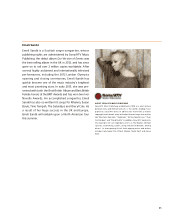Sony 2013 Annual Report Download - page 46
Download and view the complete annual report
Please find page 46 of the 2013 Sony annual report below. You can navigate through the pages in the report by either clicking on the pages listed below, or by using the keyword search tool below to find specific information within the annual report.
Responsible Sourcing
Sony is committed to conducting its operations in a
socially and environmentally responsible manner
and to sourcing from suppliers that share its values.
Accordingly, in order to enable positive change in its
supply chain, Sony works closely with its suppliers and
subcontractors to address human rights, labor, health
and safety, and environmental protection issues related
to the procurement of raw materials and components.
As part of its overall efforts to promote these
responsible sourcing initiatives, Sony engages in active,
ongoing dialogue with a range of nongovernment
organizations (NGOs). Sony is also a participating
member of industry organizations such as the Electronic
Industry Citizenship Coalition (EICC) and the Global
e-Sustainability Initiative (GeSI), which focus on improv-
ing electronics industry supply chains from social and
environmental perspectives.
Our Approach to Conflict Minerals
The Democratic Republic of the Congo and the adjacent
countries are currently mired in conflict with armed
groups perpetuating human rights abuses in that region.
These armed groups have been trading in certain minerals
commonly found in that region—coltan (tantalum),
cassiterite (tin), gold and wolframite (tungsten)—to
finance their activities. To the extent these minerals are
found to be financing armed rebel activities, these four
minerals are commonly referred to as “conflict minerals.”
To address the “conflict minerals” situation, the United
States enacted Section 1502 of the Dodd-Frank Wall Street
Reform and Consumer Protection Act, which, beginning
in 2014 for the calendar year 2013, requires companies
covered under the Act, including Sony, to publicly disclose
certain information regarding any use of conflict minerals
in their products.
It is Sony’s policy to refrain from knowingly purchasing
any products, components or materials that contain con-
flict minerals so that it can avoid contributing to conflict
through its sourcing practices. To help ensure compliance
with this policy, Sony has exercised due diligence since
August 2011 for selected product categories, and in 2013,
overall across the Sony Group to determine the country of
origin and chain of custody for each of the four designated
minerals in its supply chain in accordance with the OECD
Due Diligence Guidance for Responsible Supply Chains of
Minerals from Conflict-Aected and High-Risk Areas. It is
also Sony’s policy to require its suppliers to source these
minerals from smelters determined to be compliant with
EICC/GeSI Conflict-Free Smelter (CFS) Program* protocols
or determined to be conflict-free under other trusted
traceability projects.
Sony also actively cooperates with and provides support
for the EICC and other industry organizations and alliances
whose activities are focused on preventing and reducing
the impact of conflict minerals mining, and participates in
the Public-Private Alliance for Responsible Minerals Trade
(PPA), a joint eort of government, industry and NGOs led
by the U.S. government to support responsible mineral
trade from the Great Lakes region of Central Africa.
* CFS Program: A voluntary program in which an independent third party
evaluates a smelter’s procurement activities and determines if the
smelter has demonstrated that all the materials it processed originated
from conflict-free sources
44
























